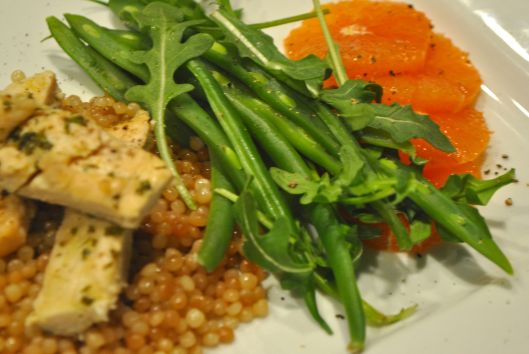
I thought, with my often simple food on my YouTube site (and my other shows over the years), I had showed viewers how easy it is to get into the kitchen and actually whip up something to eat. Not fancy pants over the top stuff that would make restaurateurs green with envy – just something simple and dead tasty.
“If you throw something in the oven, what’s to stop it from getting done?” – Phyllis Diller
No, not quite that simple, but pretty basic none the less.
Well, it seems I haven’t quite achieved my aim. I recently got an email from Doris, who said she had tried one of the simple recipes from YouTube and it was an unmitigated disaster. And while, of course, I would not caste any aspersions on Doris’s ability to follow even the most basic of instructions, can I throw in a few pointers?
First of all, when following a recipe, read it carefully (or if it’s on TV, watch it carefully ). Then sort out all the ingredients needed, measure them and put them on the bench near the stove along with the necessary cooking equipment. And, note this, the first time you try a particular recipe, DO NOT MAKE ANY CHANGES FIRST UP. Once you have mastered the dish, you can start varying it. But, at the risk of repeating myself, not until you have mastered that recipe are you allowed to muck around with it. And that includes “Oh, I haven’t got any plain flour/stock/soy, so I’ll just replace it with cornflour/water/Worcestershire or whatever else is in my pantry.
So, now that we’ve sorted that out, what about a recipe that I hope will help even Doris? A paillard may sound a bit fancy, but what we are actually talking about is a thin slice of something that will cook within minutes. (For example, a minute steak is basically a paillard.) And, they can be made with anything from a boneless, skinless chicken breast or thigh, pork loin or fillet, well trimmed Porterhouse or Scotch fillet, any steaky fish that takes your fancy or even largish vegies such as marrow or eggplant. In the case of the vegies, all you need do is cut them in thin slices, but most other things need to be battered out (gently) between clingwrap to an even thickness, using a steak hammer or even a wine bottle. Then season well, heat some olive oil and a dollop of butter in a pan and seal quickly on both sides, making sure you get a bit of colour – the butter adds flavour and the oil stops it burning. Remove from the pan and add a flavouring or two to the pan. This can be as simple as some chopped herbs, a squeeze of lemon juice and another dollop of butter; or a good splash of white wine, stock or cider; or even a few chopped anchovies or a chilli or two; or all of the above. After additions, give the pan a good swirl and return the paillard and gently cook, turning once or twice.
Actually, one of the most famous of paillards was created by French masterchef Henri Carpentier, who was given the job in the 30’s of coming up with some dishes for a ‘posh’ train whose kitchen equipment consisted of little more than the early equivalent of a toaster oven. He put a plate in the oven until it got really hot and added a good dollop of herb butter. When the butter was bubbling, he pulled the plate out of the oven, put a paillard of wild salmon on top and cooked it purely and simply with the heat of the plate, turning over once – the patrons loved it.
But, back to my versions – a marinade will also add flavour (and tenderise same) and can be added to the pan after serving – keeping in mind that, particularly with chicken, this marinade needs to be brought to the boil before returning the meat. And a couple of dead easy marinades are: a Japanese classic, which combines equal quantities of soy, Mirin (Japanese rice wine) and sake along with, if you like, some fresh chopped ginger and spring (green) onions, and works very well. As does a pretty basic number, which involves olive oil, lemon juice and crushed garlic. Just remember – only leave your chosen protein the marinade for 15-30 mins, as the acid content can ‘cook’ the meat, poultry or fish. And the addition of other flavourings such as chilli paste, good mustard, honey and whatever is quite acceptable (as long as it tastes good).
And, of course, you need some vegies. I’ve about given up on you eating your greens, but as mentioned before – just a big pot of rapidly boiling, well salted water to which you add your greens of choice. (Don’t over crowd – the aim is to bring the water back to the boil ASAP.) Then cook until crisp-tender when checked with a small sharp knife. And, being an Aussie, we need spuds. Of course, you can just boil or roast some spuds and, in the case of boiled, toss with a good amount of butter. But, what about smashed potatoes? Boil some chats until almost tender, then put on a baking tray and push down on each one with a fork or potato masher until quite well flattened. Season and sprinkle with a little olive oil and bake until crisp-crunchy. Yummy stuff!
Now, maybe this will help Doris – maybe not – but another day we’ll talk about stews and soups, which really are almost as simple as “If you throw a few decent ingredients in a pot, what’s to stop them from getting done?”
Listen to the podcast here

http://www.hueyskitchen.com.au/
Click here to go to Hueys Youtube channel
Who Is Iain “Huey” Hewitson
Born 4 October 1948 (age 69)
Otaki, New Zealand
Culinary career
Iain “Huey” Hewitson (born 4 October 1948 in Otaki), is a New Zealand-born chef, restaurateur, author, and television personality who moved to Australia in 1972.[1] He is best known for his television involvement with Network Ten. He was also the face of supermarket chain BI-LO.
image for illustration only.Photo by https://www.cookinglight.com

